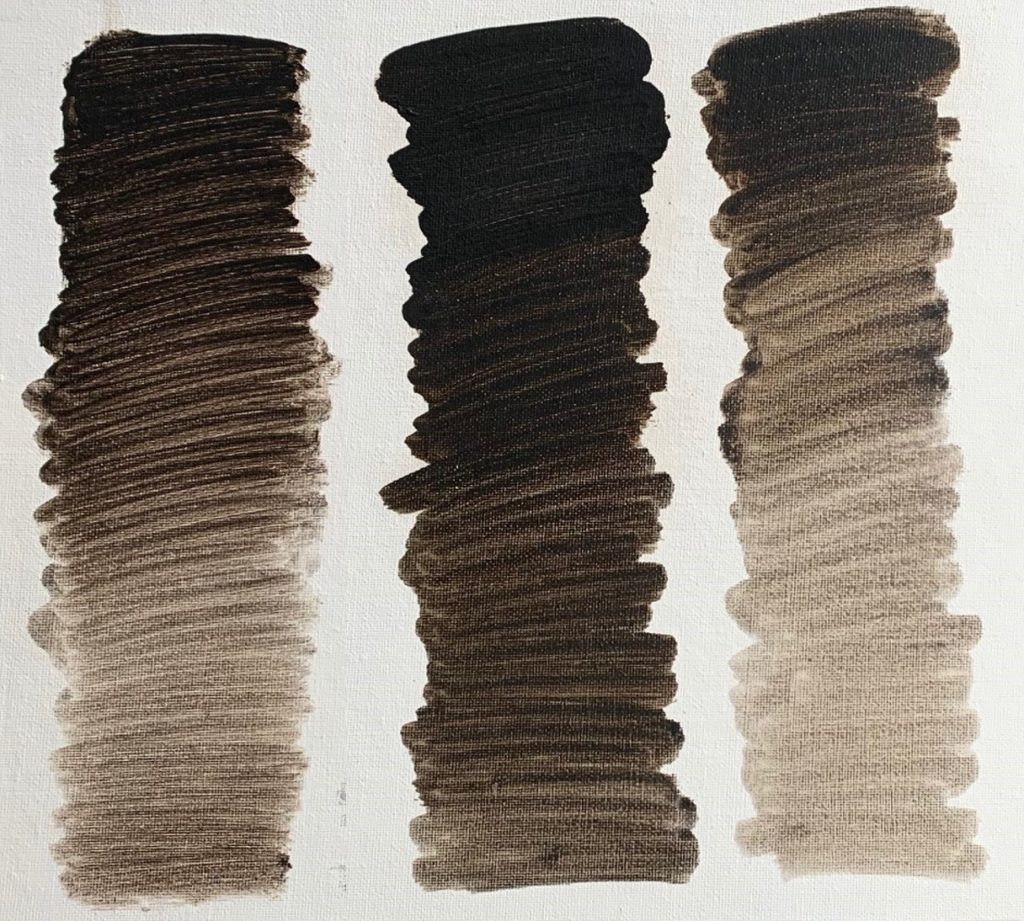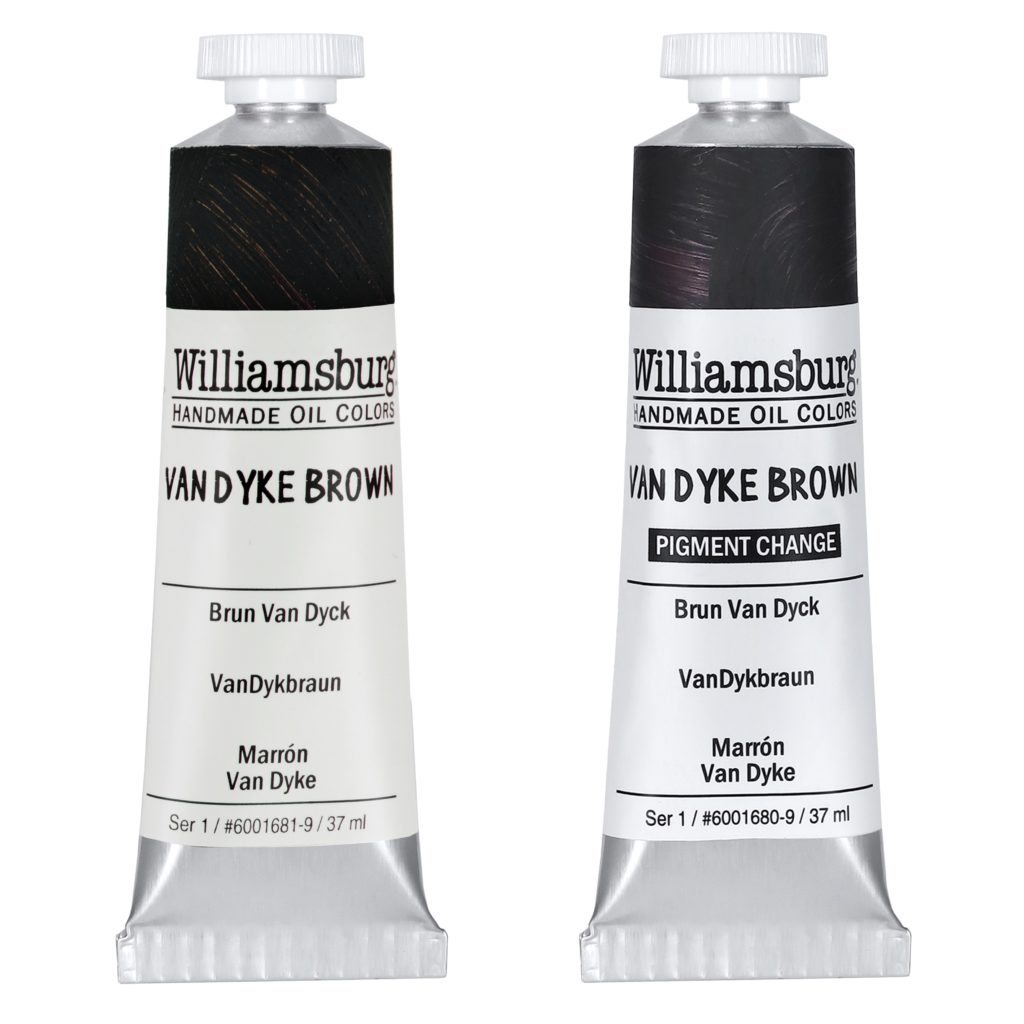Due to pigment availability issues, Williamsburg Handmade Oil Colors will unfortunately be discontinuing French Noir Indien and French Cassel Earth. We will also be changing our Van Dyke Brown from a Bituminous Earth and Raw Umber blend to a new mixture of Ivory Black and synthetic iron oxide.
The pigment used to make French Noir Indien has recently become unavailable. It was a natural black iron oxide, an excellent drier and loved for its expressive grind and warm brownish undertone. For a comparable color, try Italian Black Roman Earth, which is also a natural black iron oxide with a similar feel and an even warmer undertone and tint. French Cassel Earth will also be discontinued. It is made with a natural, tar-like material called Bituminous Earth – NBr8, which is no longer available. This is the same pigment we have used to make our Van Dyke Brown.
Although Williamsburg’s Van Dyke Brown will no longer be manufactured with Bituminous Earth, we have decided that because of its historical significance and important color space, we will keep the name but use alternative pigments moving forward. Van Dyke Brown will remain in the Williamsburg family of colors, but it will now be made with PBk9 Ivory Black and PR101 Synthetic Transparent Red Iron Oxide.
Finding a blend to replace our Van Dyke Brown was a challenge, as Bituminous Earth is a very unique pigment. When it is milled in oil, it maintains a coarse feel and when painted from the tube in full masstone, catches light on a textured surface to produce a dark, rich, dusty brown. It has a warm, semi-transparent brown undertone that when drawn thin, shows the coarseness of the pigment. It also has extremely weak tinting strength and although brown in every other way, tints with white to a fairly neutral gray. Together these characteristics are somewhat contradictory, which we did not find possible to replicate using other pigments. In the end, we decided that the dark, blackish-brown masstone and translucent brown undertone were the most important characteristics to maintain with as neutral a tint as possible. We came to settle on a semi-opaque, warm black, with tinting qualities similar to a brown umber. We thought this would be a useful color for artists looking for an alternative to the traditional blacks who want to create deep brownish glazes and warm grays.
In the new mixture, Ivory Black provides a dark base with some translucence. Transparent Red Iron Oxide has a reddish-brown color with a luminous undertone. This PR101 is the same pigment we use for our Dutch Brown (Transparent), which is a coarse color. For this blend we mill the pigment clusters to a smoother consistency. The new Van Dyke Brown is darker, browner, smoother and stronger than the old formula. You will notice tubes with the new formula labeled with the words “pigment change” under the color name to differentiate it from the old formula. It is a series 1 color and has a lightfastness rating of 1, which is excellent. We hope you enjoy this new color and invite your comments. Below are some images of Van Dyke Brown, old and new:




About Greg Watson
View all posts by Greg Watson -->Subscribe
Subscribe to the newsletter today!


Hello
I’ve never used Van Dyke or French Cassel, so one might say I don’t really mind. However since I’m quite a fan of Williamsburg :-), I might as well mention, that there (from my point of view) two possible sources of this pigment; maybe you could try them:
1.Kremer pigmente offers Van Dyck Brown, here in Europe and also in the US: https://shop.kremerpigments.com/en/pigments/pigments-of-modern-age/carbonic-blackening/5065/van-dyck-brown Also there is a sample of paint from that pigment: https://artrelatedblog.wordpress.com/2016/06/30/asphaltum-van-dyke-brown-cassel-earth-and-anthracite/
2. Natural pigments also has Cassel Earth from Europe: https://www.naturalpigments.com/cassel-earth-pigment.html
Hello Ivan,
Thanks for your comment. This is great information for our customers who might want to make their own paint using this pigment. While Bituminous Earth can still be purchased through Kremer and Natural Pigments, its availability does not seem to be supported by larger industry in general. There may be small sources that provide this pigment for years to come, but we didn’t want to be switching from one source to another as more of this resource is depleted or no longer offered by pigment manufacturers. We decided it was more important to launch this new blend to provide a consistent product in feel and color that Williamsburg users can depend on for decades to come.
We hope you enjoy!
Greg
I had a play in your virtual colour mixer with heavy body colours. I got a dark brown which tints to grey with this combination:
Red Oxide – 4 parts
Bone Black – 4 parts
Phthalo Green BS – 1 part
Might help 🙂
Hello Richard,
That is a really nice mixture – similar to Mars Violet or Red Umber in Williamsburg. You will find that our new Van Dyke Brown is much darker in the masstone, almost like a warm black. During testing, we were able to find mixtures that provided a neutral tint, but they didn’t have the reddish undertone we were after. We also wanted to minimize the number of pigments used in this color, as it becomes more challenging to match the standard each time we run a batch with more pigments.
Thanks for your comment!
Best,
Greg
I was sincerely disappointed with the new formula for Van Dyke Brown. Because of your past formula was so outstanding, i only bought Van Dyke Brown from Williamsburg. Now your formula is just like all the others, and certainly does not function the same. Very disappointing.
Hello Pat,
We are sorry to hear about your disappointment. We knew this would be a real loss for some. Unfortunately, we are unable to get this pigment any longer and there are truly no other single pigments or blends that function the way Bituminous Earth does. The warm masstone, neutral tint and weak tinting strength could not be found with any other blends. Of course, there are colors that matched one or the other, but not all three of these qualities. Every now and again we are faced with pigment availability issues that leave us no choice but to discontinue a color. We are also saddened by the loss of this very unique color.
Greg